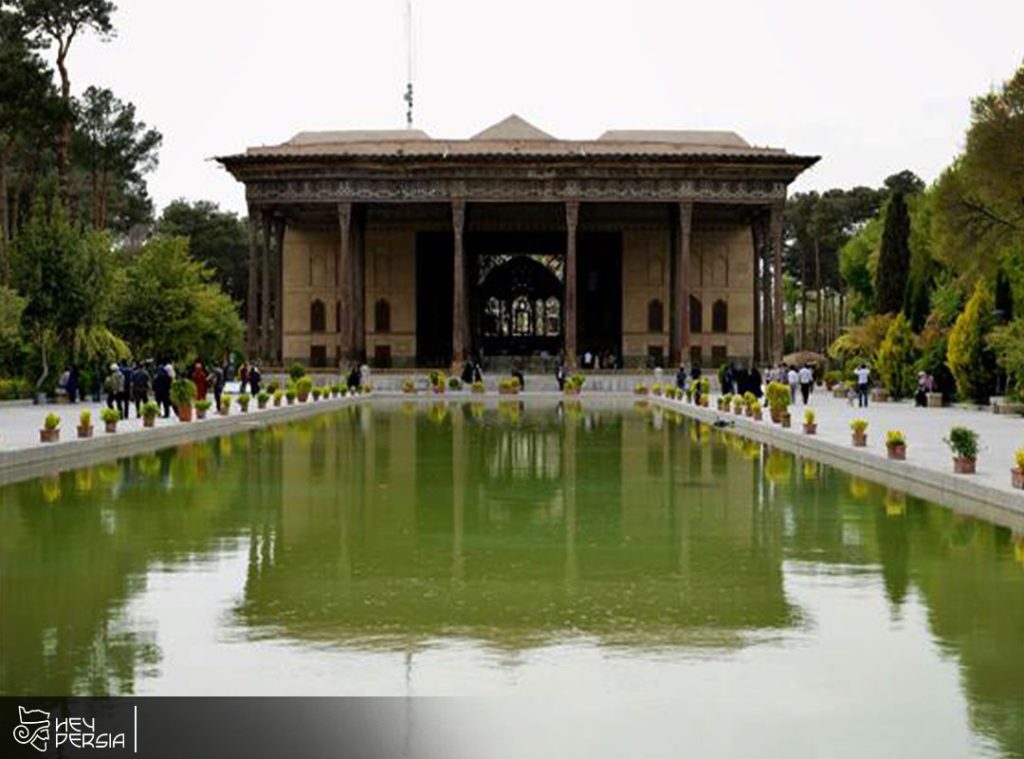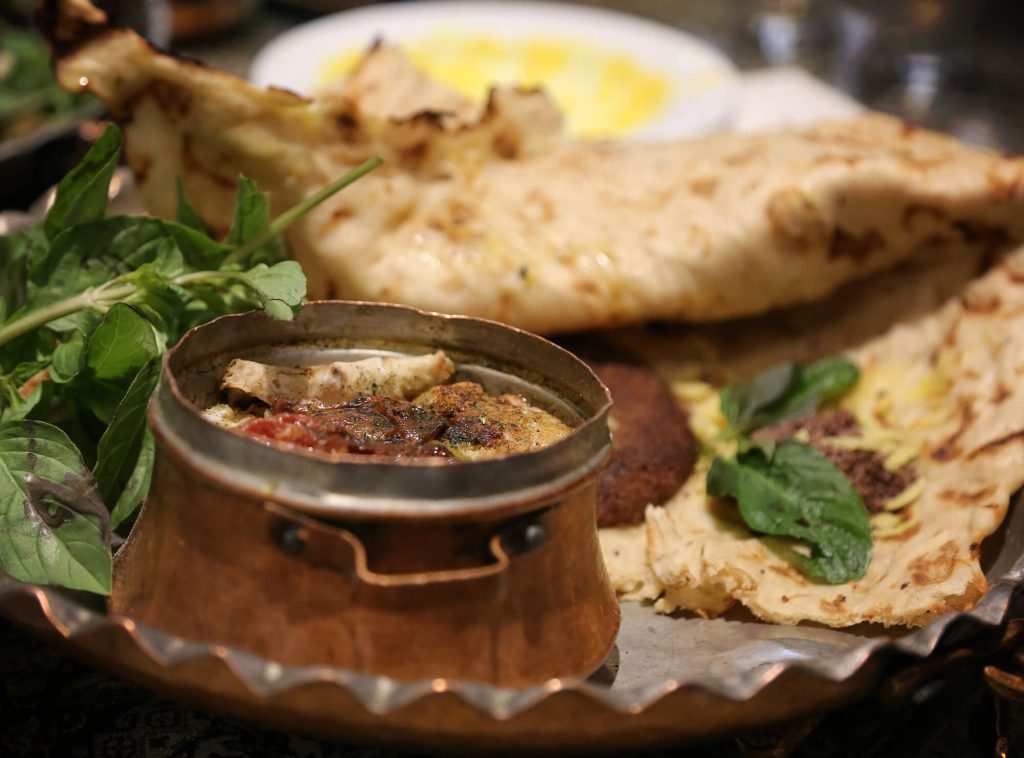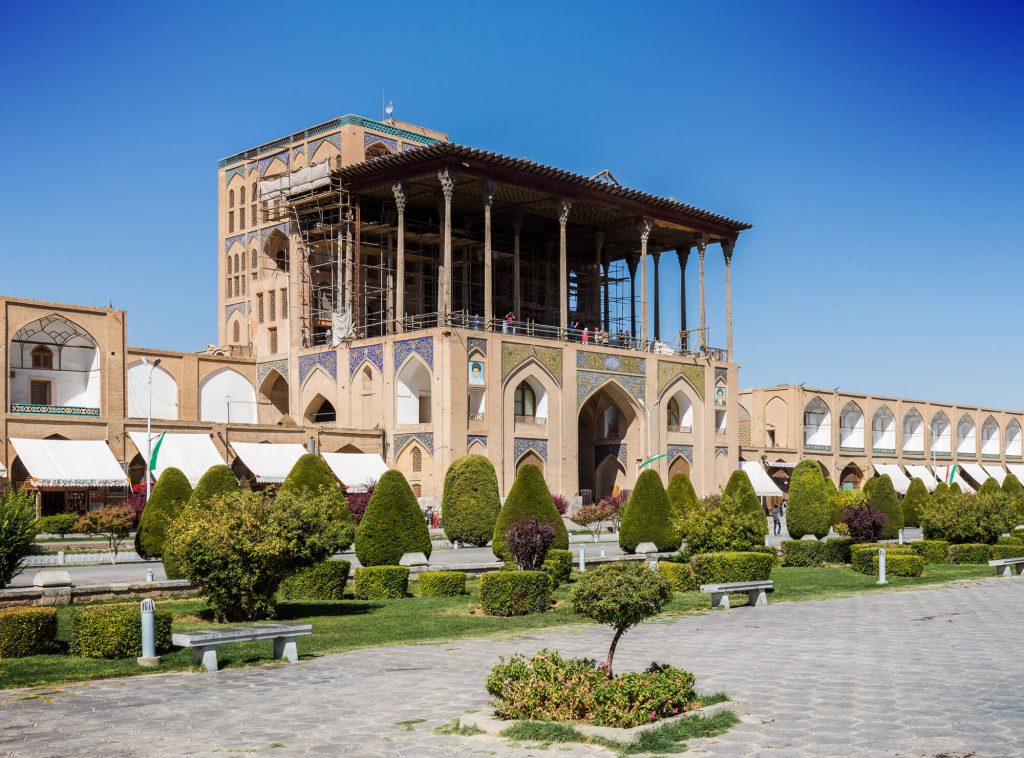“Chehel Sotoun Palace in Iran” is one of those historical buildings that you travel to the distant past and even to the time of its construction during the period of Shah Abbas I. In this fascinating historical space, which is also as the “most blessed building in the world”, you can closely watch the art of the artists of this land and immerse yourself in the awe, splendor and majesty of this historical work in the mysterious atmosphere of colors.
This time, we want to go on a cultural journey in the heart of Isfahan city in Hey Persia blog series and visit one of the most beautiful and famous places of interest in this region, Chehel Sotoun Palace. Would you like to join us on this virtual journey?
Where is Chehel Sotoun Palace?
This 67,000 square meter palace is in south of Sepeh Street and west of Naghsh-e Jahan Square in Isfahan and is one of the examples of royal gardens remaining from the Safavid period, which is also known as a museum garden.
Getting to know the history of Chehel Sotoun Palace
Chehel Sotoun Garden of Isfahan is a part of the big “Jehannama” garden, where Shah Abbas I decided to build a small pavilion in it. This hut became the initial core of Chehel Sotoun Palace construction during the reign of Shah Abbas II. Chehel Sotoun Palace is famous among domestic and foreign tourists and artists due to its unique architecture, large swimming pool, eye-catching wall paintings and mirror works, very artistic inlays. Chehel Sotoun collection was in the list of national works of Iran in 1310. Currently, this building has turned into a museum garden and is a place where manuscripts are. In 2011, Isfahan’s Chehel Sotoun Garden was as one of the 9 Iranian gardens in the UNESCO list.
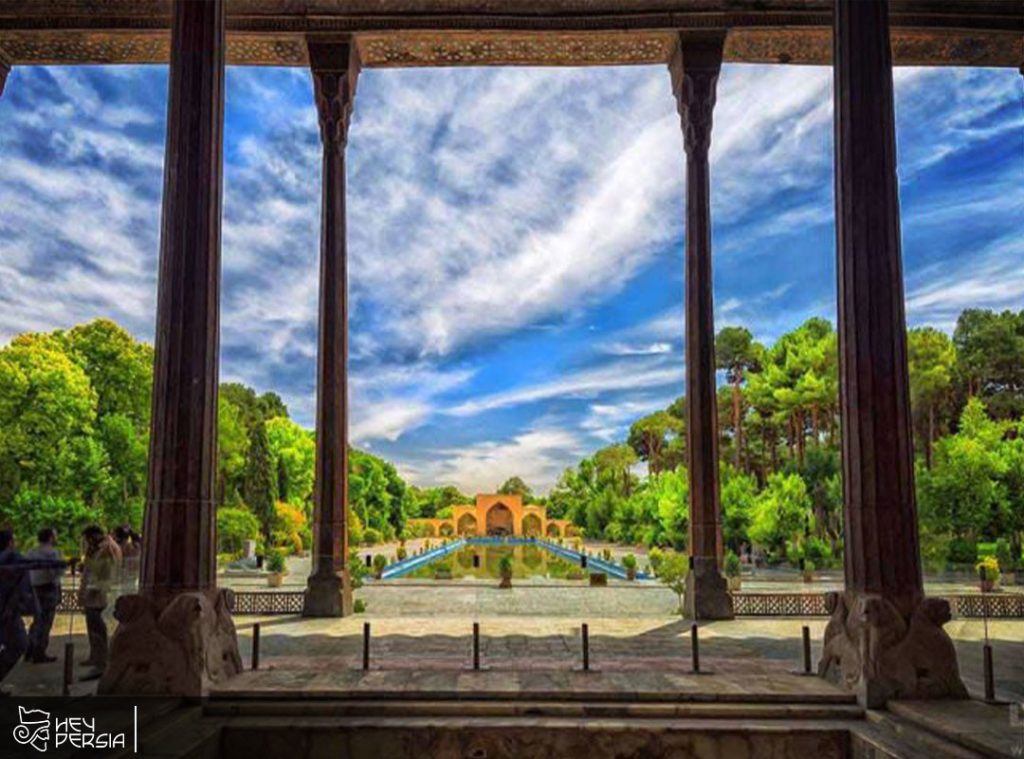
Architecture of Chehel Sotoun Palace
As we said, the first light for the construction of Chehel Sotoun Palace was during the Safavid period of Shah Abbas I. Shah Abbas ordered the construction of a pavilion in the heart of this garden in order to rest and relax a little from the affairs of the country. This small and simple pavilion was the introduction of serious changes in this complex and its transformation into a garden and a palace. Shah Abbas II decided to turn Kushk into a house government.
So by making some changes, he made it wider and finally turned it into a palace. He ordered to paint all the external and internal walls of the palace with mirrors, parts such as the hall of mirrors, the large pond in the middle of the garden, decorated ceilings and side porches were to the pavilion during this period. This space became so beautiful that today, after the Golestan Museum Palace, it ranks second among the country’s old museum palaces.
Does it really have forty columns?
Surprisingly, Chehel Sotoun (Which means 40 columns), contrary to its name, has 20 columns. There are two reasons why this mansion is called Chehel Sotoun: the reflection of the columns in the rectangular pool adjacent to the palace has caused the number of columns to be seen twice. The next issue is the importance of the number 40 in Iranian culture and literature, which shows the plurality of mystical and religious issues. It’s like hanging out, forty wigs. The best time to visit Chehelston Palace is spring and summer due to the cold weather and the greenery of the garden.
Different parts of Chehel Sotoun collection
In this part, we will introduce you to different parts of Chehel Sotoun Palace and Garden. So join us:
Entrances and Chehel Sotoun Garden
Chehel Sotoun Garden has an area of 2130 square meters, has 3 entrances and the main entrance is located in the eastern part. When you enter the garden area, you will encounter a large pool that consists of two parts. Its main part is rectangular and measures 16×108 square meters and is located in front of the mansion, the second part is located behind the palace.
Surrounding the pool are stone statues of lions and Anahita, the goddess of water. It is that these statues brought to this place from different places in Isfahan and their history dates back to the Safavid era. In the past, the water of the garden was from underground water that flowed from the end of the garden to Naqsh Jahan square. But today, the main source of water for the garden is a deep well.
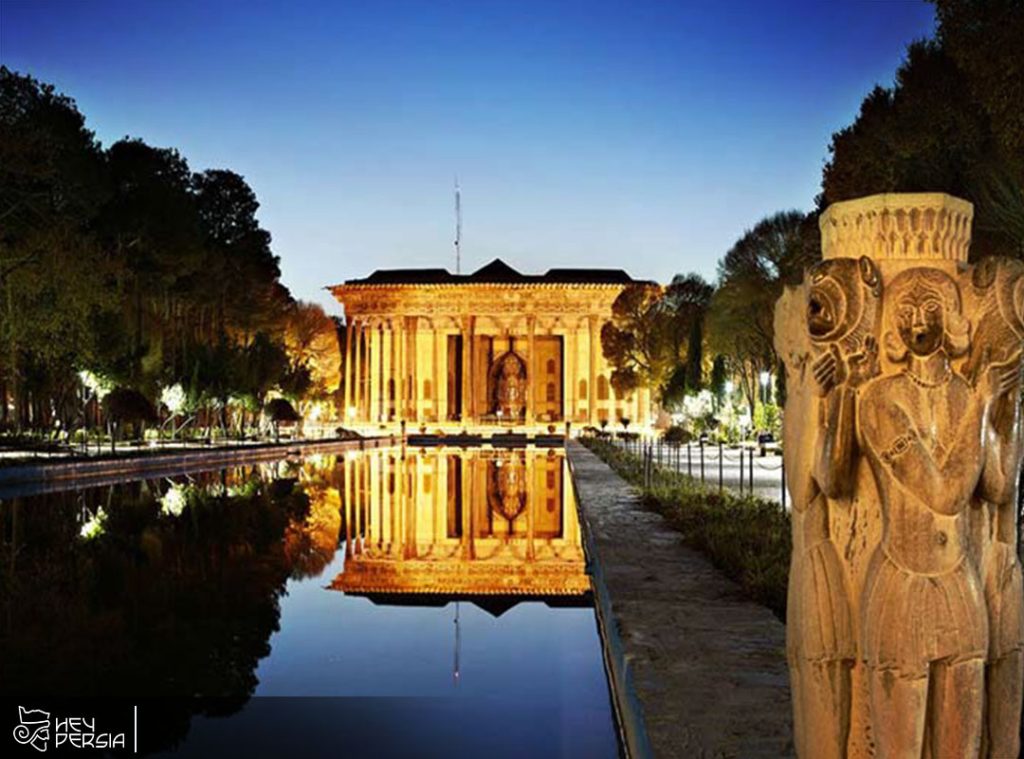
Kolah Farangi mansion Chelestun
Kolah Farangi mansion is located in the middle of Chehel Sotoun garden and its dome is conical. What attracts your attention at first sight of the mansion is the presence of 18 wooden columns with wooden and stone bases. As we have mentioned, each of the columns is a plantain or pine tree trunk, which was with mirrors in the distant past, but in the Qajar period and during the time of “Zal-ul-Sultan”, they were! There are four pillars in the middle of Kolah Farangi mansion, which are on the heads of stone lions. In the past, water came out of the mouth of the stone lions in the form of a fountain and poured into the marble pool. But nowadays there is no news about fountains and…
Hall of mirrors
As its name suggests, the Hall of Mirrors is with mirrors. The ceiling of the hall is with wooden frames and geometric designs, and there is an inscription on the top of the hall from the era of Shah Abbas II, which mentions the time of building. There is a very small section measuring 5.5 x 7 meters behind the Hall of Mirrors, which is with very small mirrors and is called the royal section.
Main Hall or Ashraf Hall
Upon entering the Ashraf Hall, you will enter the most beautiful part of the palace, which in the past was a place for receiving guests and holding various ceremonies. These days, the main hall has become Chehel Sotoun Museum. In the main hall, you will encounter a very high and dome-shaped ceiling with small and large laths and bergamots, which are in different colors of azure blue, gold, pale green, orange and very delicate green.

Ashraf Hall
The most amazing part of Chehel Sotoun Palace is the main hall or Ashraf Hall.
South pillared porch
At the end of Chehel Sotoun Palace, Isfahan, you can see the south columned porch with paintings from the Safavid era. This part has less painting than other parts.
Visiting time of Chehel Sotoun Palace
It is possible to visit this historical complex every day except mourning days and official holidays. It is open every day from 9 am to 5 pm and it is possible to visit it.
Interesting facts about Chehel Sotoun Palace
In this section, we point out some interesting points to know about Chehel Sotoun Palace in Isfahan:
- Each of the columns of the palace is the trunk of a plantain or pine tree, which are on stone foundations.
- In the past, all the columns of the palace were mirrored. But during the reign of Zal al-Sultan, the son of Naser al-Din Shah Qajar, they removed all the decorations on the columns and covered the wall paintings with plaster. The sculptures around the pool belonged to two mansions, indoor and mirror house, which were to the palace.
- In the past, Chehel Sotoun garden was accessed by a secret way with the area around the garden, in addition, there was also a secret way from Aali Qapu Palace to Chehel Sotoun. There are four statues around the large pond, all of them of Anahita, the goddess of water. On the walls of the western and southern sides of the garden, there are historical works such as the entrance of the Qutbia Mosque, the corner entrances of the Kushk door, and the works of the Darb Jubareh Mosque and the Aghasi Mosque.
- Chehel Sotoun Palace has been damaged twice in history. The first time during the reign of Shah Sultan Hossein, that it suffered a fire. The second time was related to the rule of Zal al-Sultan, who destroyed different parts of the palace with his carelessness. Chehel Sotoun Palace in Iran was renovated and restored during the Pahlavi era and was finally selected as a museum.
Chehel Sotoun Collection
Due to the artistry of its architects, the Chehel Sotoun complex is so enchanting that it has been in the list of national works of Iran and has been registered as one of the Iranian gardens by UNESCO.
Chehel Sotoun Palace in Iran
In this article, we tried to talk to you about the 67,000-square-meter garden and palace of Chehel Sotoun Palace in Iran, and from the time of its initial construction until it seriously damaged by Nasereddin Shah’s son, and finally, we talked with you about its restoration and conversion into a museum. If you also visited this historical collection or if you have more information about it, you can write them in the comments and suggestions section and share them with us. Thank you in advance for your cooperation.
Hey Persia tourism magazine has launched with the aim of getting to know more Iranians who are enthusiastic and interested in this land and water. If you also want to know more about our vast country, you can register on Hey Persia website and learn about the most important events and tourist places of our country.

